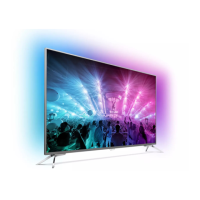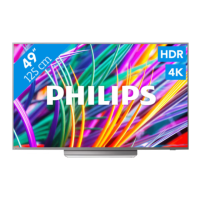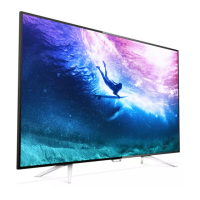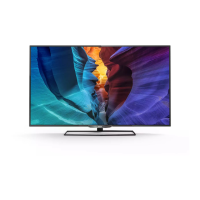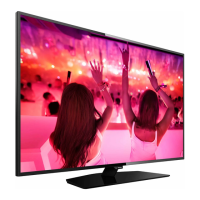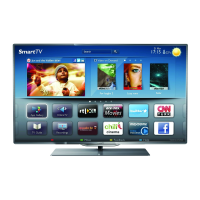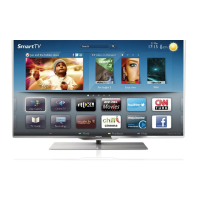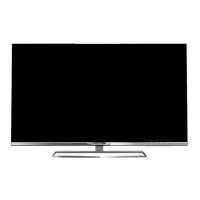Do you have a question about the Philips 49PUS6401 and is the answer not in the manual?
Introduces the new engine for smart TV apps and browser.
Emphasizes reading safety instructions before using the TV.
Instructions for attaching TV stand or wall mounting bracket.
Instructions for connecting and handling the power cable.
How to connect an antenna cable for DVB-T/C signals.
Instructions for connecting a satellite dish via F-type connector.
Details the functions of each button on the remote control.
Procedures for switching the TV on, to standby, or off.
Basic TV operations using buttons on the TV itself.
Guide to installing satellite channels and configuring settings.
Procedures for updating and reinstalling channels via antenna or cable.
General advice on connecting devices and using the connectivity guide.
Details on HDMI connections, quality, HDCP, and ARC.
Connecting and managing Bluetooth devices like speakers and gamepads.
Connecting game consoles via HDMI or SCART for optimal setup.
Connecting and formatting a USB drive for recording and pausing TV.
Connecting and configuring a USB keyboard for text input.
Guide to connecting the TV to a home network via Wi-Fi or wired connection.
Instructions for signing into Google for app access and personalized features.
Overview of the Home menu, its organization, and features.
Using Google Play for Movies & TV, Music, and Games.
Instructions for using the TV's built-in internet browser.
Explanation of the TV Menu as an alternative to the Home menu.
How to switch between connected devices like tuners, USB drives, or players.
Assigning icons and types to connected devices for better source management.
Adjusting picture settings like style, colour, contrast, and sharpness.
Configuring sound settings, styles, bass, treble, and surround modes.
Adjusting Ambilight brightness, saturation, and styles for immersive lighting.
Managing energy saving features like Eco mode and screen off.
Configuration options for USB drives, keyboards, and logo brightness.
Setting parental ratings and app locks to restrict content access.
Viewing media files from USB drives or hard drives.
Accessing media files stored on computers or NAS devices.
Playing media from cloud storage services like Dropbox.
Accessing and managing favorite, popular, and recently played media files.
Overview of the TV Guide and its capabilities for viewing schedules.
Navigating the TV Guide, tuning to programs, and setting reminders.
Scheduling and managing TV program recordings using a USB Hard Drive.
Using the pause TV function and replaying broadcasts.
Using the mobile app to control the TV and stream content.
Casting content from mobile apps to the TV screen.
Connecting mobile devices via MHL for screen mirroring and charging.
Requirements for playing games from the App Gallery or Google Play.
Steps to start and stop games from the Home menu or a game console.
Setting Ambilight to follow video, audio, or a preset color style.
Instructions to switch off the Ambilight feature.
Viewing personalized TV program recommendations and popular content.
Accessing missed or favorite TV programs for free viewing.
Watching TV channel alongside HDMI device video in Multi View.
How to update TV software from the internet or a USB drive.
Enabling automatic software updates for the TV.
European Energy Label and product environmental information.
Electrical specifications including mains power and temperature range.
Details of all TV input/output connections and supported formats.
Audio specifications including WOOX, HD Stereo, and Dolby Digital Plus.
How to access the on-screen help and user manual.
Common issues like TV not switching on or remote control problems.
Contact information and procedures for seeking support or repair.
Important safety instructions to prevent injury, fire, and electric shock.
Guidelines for cleaning and maintaining the TV screen to avoid damage.
Legal terms and conditions for using the TV product.
Trademark information for MHL technology.
Trademark information for HDMI technology.
Trademark information for Microsoft Windows Media and PlayReady.
Introduces the new engine for smart TV apps and browser.
Emphasizes reading safety instructions before using the TV.
Instructions for attaching TV stand or wall mounting bracket.
Instructions for connecting and handling the power cable.
How to connect an antenna cable for DVB-T/C signals.
Instructions for connecting a satellite dish via F-type connector.
Details the functions of each button on the remote control.
Procedures for switching the TV on, to standby, or off.
Basic TV operations using buttons on the TV itself.
Guide to installing satellite channels and configuring settings.
Procedures for updating and reinstalling channels via antenna or cable.
General advice on connecting devices and using the connectivity guide.
Details on HDMI connections, quality, HDCP, and ARC.
Connecting and managing Bluetooth devices like speakers and gamepads.
Connecting game consoles via HDMI or SCART for optimal setup.
Connecting and formatting a USB drive for recording and pausing TV.
Connecting and configuring a USB keyboard for text input.
Guide to connecting the TV to a home network via Wi-Fi or wired connection.
Instructions for signing into Google for app access and personalized features.
Overview of the Home menu, its organization, and features.
Using Google Play for Movies & TV, Music, and Games.
Instructions for using the TV's built-in internet browser.
Explanation of the TV Menu as an alternative to the Home menu.
How to switch between connected devices like tuners, USB drives, or players.
Assigning icons and types to connected devices for better source management.
Adjusting picture settings like style, colour, contrast, and sharpness.
Configuring sound settings, styles, bass, treble, and surround modes.
Adjusting Ambilight brightness, saturation, and styles for immersive lighting.
Managing energy saving features like Eco mode and screen off.
Configuration options for USB drives, keyboards, and logo brightness.
Setting parental ratings and app locks to restrict content access.
Viewing media files from USB drives or hard drives.
Accessing media files stored on computers or NAS devices.
Playing media from cloud storage services like Dropbox.
Accessing and managing favorite, popular, and recently played media files.
Overview of the TV Guide and its capabilities for viewing schedules.
Navigating the TV Guide, tuning to programs, and setting reminders.
Scheduling and managing TV program recordings using a USB Hard Drive.
Using the pause TV function and replaying broadcasts.
Using the mobile app to control the TV and stream content.
Casting content from mobile apps to the TV screen.
Connecting mobile devices via MHL for screen mirroring and charging.
Requirements for playing games from the App Gallery or Google Play.
Steps to start and stop games from the Home menu or a game console.
Setting Ambilight to follow video, audio, or a preset color style.
Instructions to switch off the Ambilight feature.
Viewing personalized TV program recommendations and popular content.
Accessing missed or favorite TV programs for free viewing.
Watching TV channel alongside HDMI device video in Multi View.
How to update TV software from the internet or a USB drive.
Enabling automatic software updates for the TV.
European Energy Label and product environmental information.
Electrical specifications including mains power and temperature range.
Details of all TV input/output connections and supported formats.
Audio specifications including WOOX, HD Stereo, and Dolby Digital Plus.
How to access the on-screen help and user manual.
Common issues like TV not switching on or remote control problems.
Contact information and procedures for seeking support or repair.
Important safety instructions to prevent injury, fire, and electric shock.
Guidelines for cleaning and maintaining the TV screen to avoid damage.
Legal terms and conditions for using the TV product.
Trademark information for MHL technology.
Trademark information for HDMI technology.
Trademark information for Microsoft Windows Media and PlayReady.
| Screen shape | Flat |
|---|---|
| Response time | - ms |
| Display diagonal | 49 \ |
| Display brightness | 350 cd/m² |
| Native aspect ratio | 16:9 |
| Display diagonal (metric) | 123 cm |
| Screen format adjustments | Zoom |
| PC in (D-Sub) | No |
| RF connector type | IEC |
| HDMI ports quantity | 4 |
| Common interface (CI) | Yes |
| USB 2.0 ports quantity | 3 |
| Component video (YPbPr/YCbCr) in | 1 |
| Consumer Electronics Control (CEC) | EasyLink |
| USB 3.2 Gen 1 (3.1 Gen 1) Type-A ports quantity | 0 |
| AC input voltage | 220 - 240 V |
| AC input frequency | 50 - 60 Hz |
| Power consumption (standby) | 0.3 W |
| Power consumption (typical) | 87 W |
| Package depth | 160 mm |
| Package width | 1200 mm |
| Package height | 747 mm |
| Package weight | 14700 g |
| User memory | 8 GB |
| Ambient lighting type | 2-sided |
| Annual energy consumption | 127 kWh |
| On/off switch | - |
| Product color | Silver |
| Panel mounting interface | 400 x 200 mm |
| Audio formats supported | AAC, MP3, WAV, WMA |
| Image formats supported | JPG |
| Video formats supported | AVC, AVI, H.264, MKV, MPEG1, MPEG2, MPEG4, VC-1, WMV9 |
| Subtitle formats supported | SMI, SRT, SUB, TXT |
| Video apps | YouTube |
| Lifestyle apps | Google Apps |
| Operating system version | 5.1 Lollipop |
| Operating system installed | Android |
| Programming period | 8 day(s) |
| Firmware upgradeable via | Auto upgrade wizard, Network, USB |
| RMS rated power | 20 W |
| Tuner type | Analog & digital |
| Analog signal format system | NTSC, PAL, SECAM |
| Digital signal format system | DVB-C, DVB-T, DVB-T2 |
| Operating temperature (T-T) | 5 - 35 °C |
| Cables included | AC |
| Depth (with stand) | 213 mm |
|---|---|
| Height (with stand) | 670 mm |
| Weight (with stand) | 11300 g |
| Depth (without stand) | 79 mm |
| Width (without stand) | 1099 mm |
| Height (without stand) | 645 mm |
| Weight (without stand) | 11000 g |
